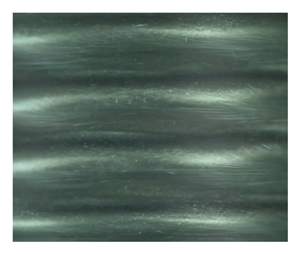Article contents
Counter-rotating suspension Taylor–Couette flow: pattern transition, flow multiplicity and the spectral evolution
Published online by Cambridge University Press: 27 June 2022
Abstract

Inertial transitions in a suspension Taylor–Couette flow are explored for the first time via experiments in the counter-rotation regime (i.e. the rotation ratio  $\varOmega =\omega _o/\omega _i<0$, where
$\varOmega =\omega _o/\omega _i<0$, where  $\omega _i$ and
$\omega _i$ and  $\omega _o$ are the angular speeds of the inner and outer cylinders, respectively) up to a particle volume fraction
$\omega _o$ are the angular speeds of the inner and outer cylinders, respectively) up to a particle volume fraction  $\phi \leq 0.2$. The primary bifurcation from the circular Couette flow (CCF) is found to yield patterns similar to those in a particle-free Newtonian fluid, and is supercritical at
$\phi \leq 0.2$. The primary bifurcation from the circular Couette flow (CCF) is found to yield patterns similar to those in a particle-free Newtonian fluid, and is supercritical at  $|\varOmega |\leq 0.5$ but becomes hysteretic at large
$|\varOmega |\leq 0.5$ but becomes hysteretic at large  $|\varOmega |=1$. It is shown that the states with different numbers of vortices can coexist over a large range of shear Reynolds number
$|\varOmega |=1$. It is shown that the states with different numbers of vortices can coexist over a large range of shear Reynolds number  $\mbox {Re}_s(\phi )$, confirming multi-stable behaviour of the primary and higher-order states for any particle loading at
$\mbox {Re}_s(\phi )$, confirming multi-stable behaviour of the primary and higher-order states for any particle loading at  $|\varOmega |\leq 0.5$. A quasi-periodic state characterized by two incommensurate frequencies, namely, the modulated wavy vortices (MWV), is found at
$|\varOmega |\leq 0.5$. A quasi-periodic state characterized by two incommensurate frequencies, namely, the modulated wavy vortices (MWV), is found at  $\varOmega =-0.5$ as a tertiary bifurcation from the wavy Taylor vortices (WTV), with the stationary Taylor vortex flow (TVF) being the primary bifurcating state from CCF at
$\varOmega =-0.5$ as a tertiary bifurcation from the wavy Taylor vortices (WTV), with the stationary Taylor vortex flow (TVF) being the primary bifurcating state from CCF at  $\phi \geq 0$. A novel sequence of transitions
$\phi \geq 0$. A novel sequence of transitions  ${\rm TVF}\to {\rm MWV}_1\to {\rm WTV}\to {\rm MWV}$, with another variant of modulated vortices (MWV
${\rm TVF}\to {\rm MWV}_1\to {\rm WTV}\to {\rm MWV}$, with another variant of modulated vortices (MWV $_1$) appearing directly from TVF as a secondary bifurcation, may also occur even for the particle-free (
$_1$) appearing directly from TVF as a secondary bifurcation, may also occur even for the particle-free ( $\phi =0$) case; the coexistence/non-uniqueness of WTV and MWV states is demonstrated over a range of
$\phi =0$) case; the coexistence/non-uniqueness of WTV and MWV states is demonstrated over a range of  $\mbox {Re}_s$ values spanning the secondary and tertiary bifurcation loci. At
$\mbox {Re}_s$ values spanning the secondary and tertiary bifurcation loci. At  $\varOmega =-1$, the primary bifurcation yields an oscillatory state (spiral/helical vortex flow) that gives birth to another oscillatory state (interpenetrating spiral vortices) and a non-periodic state (non-propagating interpenetrating spirals, NIS) as secondary and tertiary bifurcations, respectively, with NIS being characterized by the absence of frequency peaks in the power spectrum of the scattered light intensity. For all transitions at
$\varOmega =-1$, the primary bifurcation yields an oscillatory state (spiral/helical vortex flow) that gives birth to another oscillatory state (interpenetrating spiral vortices) and a non-periodic state (non-propagating interpenetrating spirals, NIS) as secondary and tertiary bifurcations, respectively, with NIS being characterized by the absence of frequency peaks in the power spectrum of the scattered light intensity. For all transitions at  $\varOmega < 0$, the critical values of
$\varOmega < 0$, the critical values of  $\mbox {Re}_s^c(\phi )$ decrease with increasing
$\mbox {Re}_s^c(\phi )$ decrease with increasing  $\phi$, with more destabilizing effects of particles being found at larger
$\phi$, with more destabilizing effects of particles being found at larger  $|\varOmega |$. The effect of particle loading is found to (i) decrease the amplitude and (ii) increase the wavelength of wavy vortices, with the latter seeming to be responsible for the decreased propagation frequencies of azimuthal waves with increasing
$|\varOmega |$. The effect of particle loading is found to (i) decrease the amplitude and (ii) increase the wavelength of wavy vortices, with the latter seeming to be responsible for the decreased propagation frequencies of azimuthal waves with increasing  $\phi$. The normalized rotation frequency of spiral vortices also decreases with increasing
$\phi$. The normalized rotation frequency of spiral vortices also decreases with increasing  $\mbox {Re}_s$ and
$\mbox {Re}_s$ and  $\phi$, and a scaling relation in terms of the relative viscosity is found to collapse the frequency data for all
$\phi$, and a scaling relation in terms of the relative viscosity is found to collapse the frequency data for all  $\phi$.
$\phi$.
JFM classification
Information
- Type
- JFM Papers
- Information
- Copyright
- © The Author(s), 2022. Published by Cambridge University Press
References
REFERENCES
- 7
- Cited by


